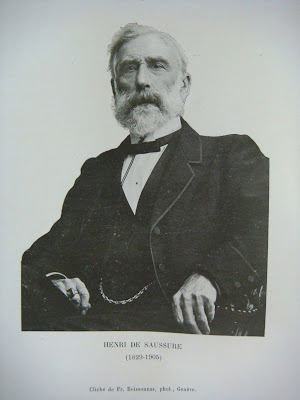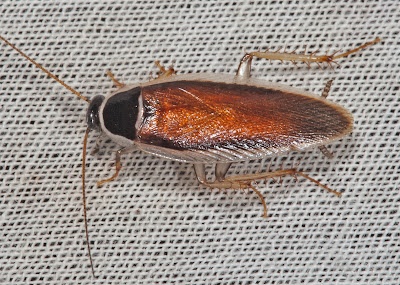Most people who deal with scientific names (Latin or
Latinised words) have some knowledge of what they mean. Generic names can be
meaningful or fanciful. It is all in the hands of the describer. As long as the
name has not been used before (is pre-occupied) and is not derisive or
needlessly obscene, most editors will accept an author’s choice.
Not all authors provide readers with the derivation of their
names.
Francis Walker named hundreds of genera and species in many groups of insects. In fact he was paid on the basis of the number of species he named. But that’s a different story. He seldom provided any information on the basis for his generic names. Examples are Dexerra Walker 1869 and Requena Walker 1869 of his genera that were named without a hint of what, if anything, they meant. Both are Australian katydids. Later Ander in 1938 described another katydid and called it Xederra without explanation. I assume it is an anagram of Dexerra. The two are only distantly related.
Francis Walker named hundreds of genera and species in many groups of insects. In fact he was paid on the basis of the number of species he named. But that’s a different story. He seldom provided any information on the basis for his generic names. Examples are Dexerra Walker 1869 and Requena Walker 1869 of his genera that were named without a hint of what, if anything, they meant. Both are Australian katydids. Later Ander in 1938 described another katydid and called it Xederra without explanation. I assume it is an anagram of Dexerra. The two are only distantly related.
I preparing the cockroach guidebook for CSIRO publications,
I was met by a number of unusual generic names. I know what they meant but
would be certain that most readers would not have a clue. Examples are Hensaussurea, Beybienkoa, Carbrunneria, Johnrehnia and Eowilsonia. You can get a hint from the last two. They are all generic names
composed by combining the first and last names of the persons to be so
honoured. [And yes, it would be an honour to have a cockroach genus named for
you!]
Here are some notes on the origins of the above names. This
may add some interest to discovering the richness of the Australian fauna.
Karl Princis, the Swedish entomologist, was the first of the
modern taxonomists to combine Christian and surnames into one latinised word.
Louis Roth, the most recent perpetrator, continued the trend with a few of his
own.
Hensaussurea
Princis 1954 (contains 11 Australian species)
Hensaussurea sheardi Roth D. Knowles photo
Named for Henri Louis Frederic de Saussure a distinguished
Swiss entomologist who was skilled in unrelated fields such as geography and
mineralogy. He founded the Geographical Society of Geneva but spent most of his
time at the Natural History Museum of Geneva.
Henri Louis Frederic de Saussure
Carbrunneria Princis (13 Australian species)
Carbunneria marci Roth
Named in honour of Karl Friedrich Brunner von Wattenwyl (1823-1914)
was a Swiss entomologist. He was director of the telegraph office in Vienna but
was mostly interested in entomology. He published many important works in the
field of orthopterology. He was also Professor of Physics at University of
Bern, 1850-55.
Karl Friedrich Brunner von Wattenwyl
Johnrehnia Roth (36 Australian species)
Johnrehnia concisa (Walker)
Named in honour of John William Holman Rehn was the son of James A. G. Rehn, Curator of
Orthoptera at the Academy of Natural Sciences of Philadelphia. He took up an
interest in Entomology and published several papers on the higher
classification of the cockroaches that were based on their wing venation. He
spent his career in the US Army.
John W. H. Rehn
Beybienkoa Roth (23 Australian and New Guinea species)
Beibienkoa kurandanensis Roth
Named in honour of Grigory Yakoveivich Bey-Bienko
(1903-1971) a Russian entomologist of considerable note. He studied many groups
of orthopteroid insects and had several genera and many species named in his
honour. Prof Bey-Bienko was the Stalin Prize winner in 1952 in honour of his
international recognition as an entomologist.
Grigory Yakoveivich Bey-Bienko
Eowilsonia Roth (3 Australian species)
Eowilsonia biglandulifera Roth
Named for Edward O. Wilson (1929-) the noted biologist,
conservationist and entomologist specialising in the study of ants. He is known
and the “Father of Sociobiology” for his books depicting the biology and
behaviour of ants. He is Professor Emeritus at Harvard University where Louis
Roth, the author of the genus, worked for many years in retirement.
Prof. Edward O. Wilson from the web
Francis Walker (1809-1864)
Paratemnopteryx centralensis (Roth)
The much maligned Francis Walker. The cockroach genus Franwalkeria Princis is named in his honour. Ironically, it is now a synonym of Paratemnopteryx!


























6 comments:
What a bunch of new information to me! Knowing that Brunner V W was a telegraph man was rather shocking. I suppose he spent a great deal of his working time practicing his hobby under the desk drawer. Fortunayelly he was the boss!!
Francisco
Thanks Francisco
D
The statement that Francis Walker was paid by the species or paid by the genus is a myth started by the lepidopterist Grote. Walker was on contract to the museum and was paid to complete each set of volumes he was contracted to do. See my bio of him in Fly Times (46:33-41, 2011), which follows up on research into the Trustees accounts regarding Walker by the hymenopterist Graham in 1979 (Ent. Gaz.)
Thanks Neal. Great to get the truth on this myth.
DR
Great compilation of stories, Dave. The histories of the naturalists and scientists involved in the finding and describing of species are often as interesting as the species themselves. Eowilsonia - what a great genus!
Thank David - Little did I realise that I was part of a long nomenclatorial tradition when I named Roynortonella and Donjohstonella, to replace two junior synonyms but keep to the intent to honour the acarologists in the original names.
Grammodes justa Walker, 1858 is one of the few attractive moths battering around my windows in the Sunshine Coast Hinterlands and I have no idea what Walker meant by the name. Grammatical just?
Post a Comment